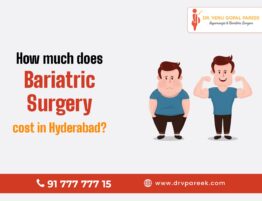Introduction About Obesity Surgery/ Bariatric Surgery
Obesity is a major health hazard affecting an almost third of our citizens.considered till now a disesase affecting developed countries, obesity is now evolving major health hazard for our country.
Physiology of obesity:
Normal gain weight when we consume more calories from food than our body uses its normal functions(basal metabolic rate-bmr)and physical activity .the unused calories are stored as fat.in many cases, the underlying cause of mormid obesity is genetic ,wherein we inherit the tendency of gain weight.genes play an important role in the tendency to gain excess weight.
Modern lifestyle and environment like fast food (high in fat and in fruits and vegetables), long sitting at desk, and suburban neighborhoods, that requires cars, all magnify hereditary factors such as metabolism and efficient fat storage.
If we try to loose weight by starving or dieting override the set point by cutting calorie intake ,our brain responds by lowering metabolism and slowly activity ,we than gain back any weigh you lost.
Health hazard s of obesity:
The severely obese person is approximately 6 times likely to develop heart disease as those who are normal-weighted . Heart disease is the leading cause of death today and obese person ten to develop it earlier in life ad it shortens it lives.
High blood pressure is much more common in obese person and leads to the development of heart disease.
An overweight person is 40times as likely to develop type-2, adult onset diabetes.
A seriously overweight person face constant challenges to their emotions: repeated failure with dieting, disapproval from family and friends and remark from strangers.
They often experience discrimination at work stereotypes of obese people-such as that there is lazy-may result in lower self esteem and poor body image.
The surgery commonly performed :
Performed entirely laparoscopically ,the procedures involes five small incisions which take about an hour .a small pouch about 120cc in size in stomach is made by using stapling devices .the stomach is removing while the gastrointetestinal track is kept ultered thus the stomach size is dramatically reduced .the laparoscopic sleeve gastrectomy operation requires 2-3 days in hospital .the patient can return to work and resume sternous activity in about 2 weeks .for those who have light duty at work ,they can possibly get back to work sooner than 2 weeks the remaining stomach is removed while the gastrointestinal track is kept ultered.
The rest of the gastrointestinal tract anatomy is not altered, so the food ingested follows the normal course.this results in less chance of developing a lot of vitamins and minerals and eliminates dumping syndrome.the procedures decrease significantly the hunger by removing the part of the stomach that produces the main stimulating hormones.minimize the chance of developing ulcers.
Lap band
The balloon, like the device, is inserted through a small incision and inflated to clinch the stomach and limits its capacity.the placement of the band creates a small pouch at the top of the stomach .this pouch holds approximately ½ cup of food, whereas the typical stomach holds about 6 cups of food .the poch fills with food quickly ,and the band slows the passage of food from pouch to lower part of the stomach .the operation takes about 60 minutes usually requires a day hospital stay the band can later be tightened or loosened as needed –without further surgery by adjusting the amount of solution through a portal under the patient’s skin .the device can ever be removed entirely if necessary reduced risk, simplicity, and reversibility make the lap band very attractive.
Gastric banding is usually not recommended for people with any of the following
1)if the surgery OT treatment represents an unreasonable risk to the patient.
2)untreated endocrine disease such as hypothyroidism
3)inflammatory disease of the gastrointestinal track such as ulcers, esophagitis or Crohn’s disease.
4)severe cardiopulmonary disease or other condition with may make them poor surgical candidates in general.
5)dependency on alcohol and drugs.
Postoperative care
The patient is explained not to underestimate the physical and social adjustments he will have to make after surgery he’ll have a stomach pouch about the size of small egg.i the first six months after surgery eating too much or too fast may cause either vomiting or can intense pain under your breastbone.
instead of eating regular sized meals three times a day .you ‘ll be required to four to six times very small meals.about 2 ounces (60ml)each.most people, however, quickly learn how much can they eat at one meal.and over time, the amount you can eat increases.
Summary
Surgery for weight reduction is not a miracle procedure .through you can generally expect to lose weight and keep it off, changes needed in your eating and exercise habits are yours to make.but health benefits of losing weight are yours as well.
Contact:
Dr.Venu Gopal Pareek
MS,DNB,FBMS FAIS,FMAS,FIAGES,
consultant laparoscopic and bariatric surgeon ,
Mobile :- 9177777715/8977777715







